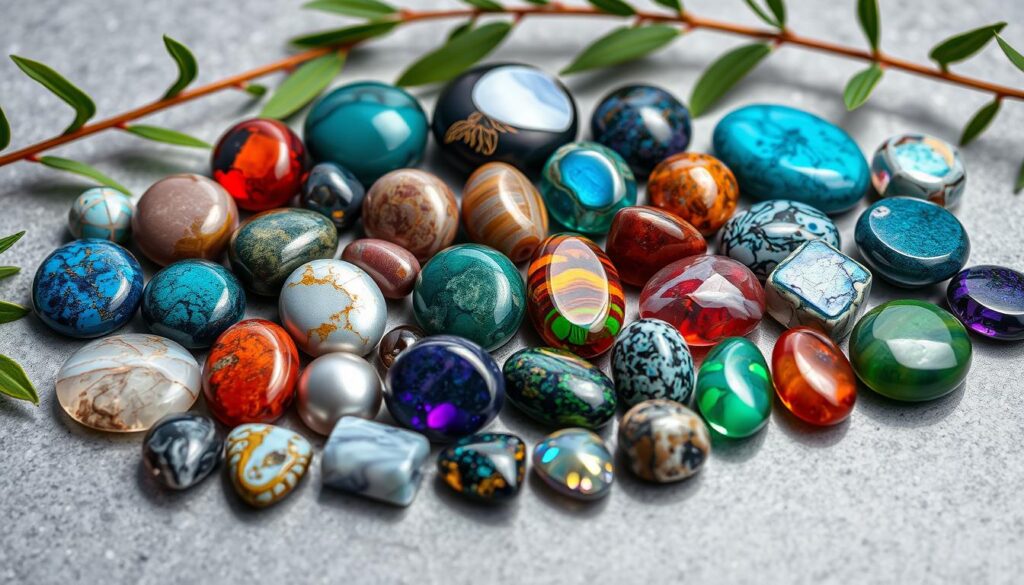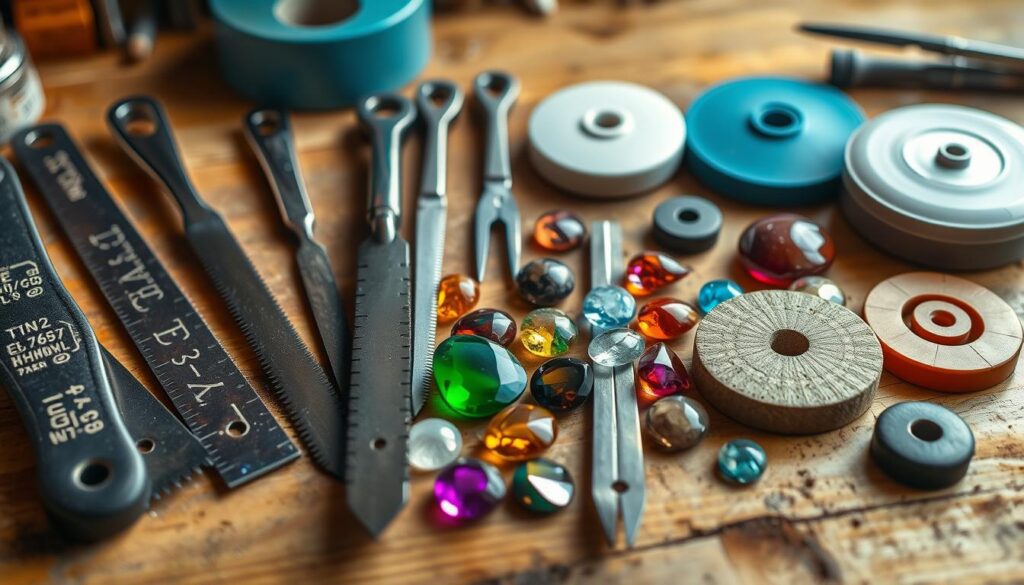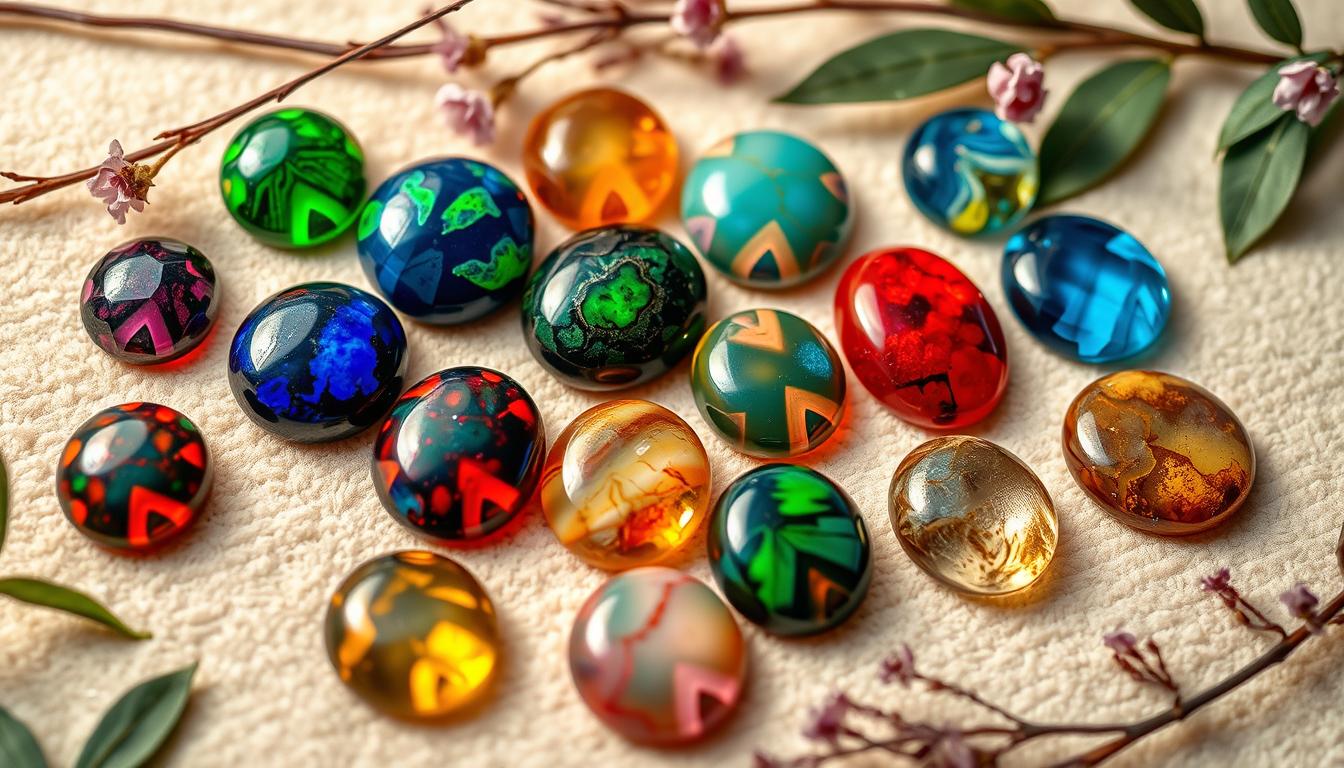This post contains affiliate links.
Ever wondered how a rough stone becomes a stunning jewel? It’s all about cabochons. These polished stones are key in jewelry making, with their smooth surfaces and bright colors. They’re perfect for anyone looking to explore the beauty of cabochons.
Cabochons are made from many materials, like moonstone and opal. Each one has its own story, shaped by nature and human skill. This guide will show you why cabochons are so special in the world of jewelry.
Starting your own collection is easy with high-quality cabochons from trusted dealers. Rock hounding enthusiasts love these polished gems. They make it simple to add beauty to your life or projects.
Join us as we explore the world of cabochons. You’ll learn about their artistry and science. This guide will help you choose the best cabochons for your needs.
Key Takeaways
- Cabochons are smooth, domed gemstones popular in jewelry making
- They come in various materials, offering a wide range of colors and properties
- Quality and variety are highly valued by cabochon enthusiasts
- Reputable dealers provide excellent customer service and fast delivery
- Cabochons can be found in standard shapes or as unique, designer cuts
- Understanding cabochon properties helps in selecting the perfect stone for your project
Understanding Cabochons: A Gateway to Gemstone Artistry
Cabochons are a special way to enjoy gemstones. These smooth, rounded stones show off the beauty of minerals without the need for facets. Cabochon stones have been loved for centuries, going back to ancient times.
What Makes a Cabochon Special
Cabochons are known for their simple yet elegant design. They’re cut from stones that are either translucent or opaque. This highlights their natural colors and patterns. The name “cabochon” comes from Old Norman French, meaning head, which suits their domed shape.
The Art of Cabochon Cutting
Creating cabochons is a form of lapidary art. It takes skill to reveal a gem’s best features. The process of cabbing includes several steps:
- Selecting the right stone
- Rough shaping
- Fine grinding
- Polishing to a smooth finish
Common Shapes and Styles
While oval cabochons are popular, many shapes exist. You’ll find round, square, heart-shaped, and freeform cabochons. Here’s a look at common cabochon styles:
| Style | Description | Popular Use |
|---|---|---|
| Standard | Smooth dome, flat bottom | Rings, pendants |
| Double Cabochon | Domed on both sides | Beads, earrings |
| Buff Top | Slightly domed top, faceted bottom | Dress jewelry |
| Intaglio | Engraved or carved design | Seals, cameos |
Cabochons are key in jewelry design. They’re set using various techniques like bezel or prong settings. Whether you’re a gem enthusiast or a budding lapidary artist, understanding cabochons opens up a world of creative possibilities in gemstone artistry.
The History and Evolution of Gemstone Cutting
Gem carving started nearly a million years ago, showing the beginning of human craftsmanship. By 3000 BC, people had learned to make detailed serpentine cylinders. They valued stones like amber, turquoise, and lapis lazuli for jewelry and charms.
The art of lapidary grew in many cultures. The Zapotecs in Pre-Columbian times worked with jade from 200 BC to 1500 AD. Ancient Indian texts from 2300 BC talk about gem-cutting methods. Rubies and sapphires, clear gems, were used in early jewelry from India, Burma, and Persia.
The Islamic Period saw big steps forward in faceting. By the 18th century, Idar-Oberstein in Germany became a key place for gem cutting. The number of shops grew from 15 to over 150 by the late 1800s. China became a big maker of commercial cabochons in the early 1900s.
In America, collecting rocks and minerals became popular hobbies. The 1970s saw a rise in the craft market. The 1980s brought a focus on investing in gemstones. Today, American designers are known for their creativity in cutting gemstones, always trying new materials and shapes.
| Year | Event |
|---|---|
| 1,000,000 BC | Earliest evidence of gem carving |
| 3000 BC | Serpentine cylinders become common |
| 2300 BC | Indian literature mentions gem-cutting |
| 200 BC – 1500 AD | Pre-Columbian Zapotec jade carving |
| 1700s | Idar-Oberstein emerges as gem cutting hub |
| 1900s | China becomes major cabochon producer |
| 1970s | Craft market surge in America |
| 1980s | Gemstone investment trend |
Essential Properties of Gemstones for Cabochons
Exploring gemstones and rock collecting? Knowing about cabochons is key. These smooth, polished stones are loved for their beauty and use in jewelry.
Hardness and Durability
The Mohs scale rates gemstone hardness from 1 to 10. Diamond is the hardest at 10, while talc is the softest. Harder stones are best for cabochons because they last longer.
You can test a stone’s hardness at home. Use a fingernail, copper penny, window glass, or a steel file to see how it compares.
Color and Transparency
Cabochons come in many colors. Some, like azurite, stay the same color. Turquoise, on the other hand, has many shades. Transparency also varies, with agates being clear and jaspers being solid.
Some stones have special effects. Tiger’s Eye shows chatoyancy, Star Rubies have asterism, and Opal fire displays iridescence.
Crystal Structure
The inside of a gemstone affects how it looks. Some glow under UV light, while others are magnetic. Knowing this helps pick the right stones for your cabochons.

Making cabochons is a mix of science and art. Learning about these properties helps you choose and work with the best stones for your projects.
Popular Gemstones for Cabbing
Cabochon cutting turns rough stones into smooth gems. This art is loved for making stunning cabochons for jewelry and mineral specimens. Let’s look at some top gemstones for cabbing.
Opaque Stones
Opaque stones are great for cabochons because of their vibrant colors and patterns. Malachite and lapis lazuli are favorites for their unique looks. Turquoise is also popular, often used in Native American jewelry.
Translucent Gems
Translucent gems create special effects when cut as cabochons. Moonstone has a dreamy glow, and opal shows a colorful play. Rose quartz is loved for its soft pink color and affordable price.
Specialty Materials
For rare and exotic cabochons, specialty materials are perfect. Madagascar’s labradorite, priced at $81.67 per piece, has a stunning iridescence. Russia’s charoite, priced at $162.50, has a unique purple swirl.
| Gemstone | Origin | Average Price |
|---|---|---|
| Lavender Quartz | Various | $137.50 |
| Webbed Variscite | Australia | $68.80 |
| Chrysoprase | Australia | $43.25 |
Whether you collect or make jewelry, these polished stones are endless possibilities. From affordable to rare, there’s a cabochon for every taste and budget. If you want to learn more about working with stones, rock tumbling is a great hobby to polish stones at home.
Tools and Equipment for Working with Cabochons
Starting in lapidary art means getting the right tools. People who cut and cab stones use special gear to make gems shine. Here’s what you need to make stunning cabochons.

First, you’ll use a trim saw to cut stones into workable pieces. Then, grinders and sanders shape them. Polishers add the final sparkle. Good tools are key for a great cabochon.
Diamond-impregnated steel bits are great for detailed work. They come with finer grits for a smooth finish. Cratex wheels, made of silicon carbide, are perfect for pre-polishing.
- Dop Master System by Diamond Pacific
- Trim Saw for Diamond Pacific Pixie Gem Maker
- Resin Bond Diamond Nova Discs
- Steel Master Laps for Magnetic Discs
- Glass/Crystal Disc Kit by Hi-Tech Diamond
Don’t forget to use lubrication when cabbing. It keeps the stone and tools cool for better results. As you get better, you might try cameo, intaglio, or reverse intaglio carving.
| Tool Type | Function | Material |
|---|---|---|
| Carving Tools | Initial shaping | Wood, metal, ceramic, plastic |
| Polishing Tools | Final finish | Felt brushes, oxide polishes |
| Cutting Bits | Detailed work | Diamond-impregnated steel |
With the right tools and patience, you’ll make beautiful cabochons. They’ll show off the gemstone’s natural beauty.
The Lapidary Process: From Rough to Polished
The journey from a rough stone to a polished gem is an art form. It requires skill, patience, and precision. Cabochon cutting, the most popular form, turns raw materials into beautiful, smooth stones. Let’s explore the steps involved in this fascinating process.
Initial Cutting and Shaping
Stone cutting starts with slabbing the gem material. A slab saw, 16 to 24 inches in diameter, cuts stones into thin slabs. For smaller stones, a trim saw is better. The oval cabochon is common, but some materials like opal are cut freeform.
Grinding Techniques
After shaping, grinding removes saw marks and refines the stone. The Genie by Diamond Pacific is a top cabbing machine for this. It’s important to keep the wheel wet during grinding. Water lubricates and carries away debris. “Peeling the apple” is a technique for cutting a bevel around the gemstone.
Final Polishing Steps
The final stage involves sanding and polishing for a mirror-like finish. Various compounds like cerium oxide and aluminum oxide are used. Diamond mesh, from 50,000 to 100,000 grit, polishes materials to perfection.
| Abrasive | Hardness (Mohs) | Use |
|---|---|---|
| Diamond | 10 | Cutting and polishing various materials |
| Silicon Carbide | 9.5 | Cutting softer gemstones |
| Aluminum Oxide | 9 | Polishing final stages |
Remember, each step in cabbing requires patience and skill. With practice, you’ll master the art of transforming rough stones into stunning gems.
Setting and Mounting Your Cabochons
After polishing your gemstones, it’s time to set and mount your cabochons. This step brings your jewelry to life. It shows off the beauty of your stones and keeps them safe.
Bezel Settings
Bezel settings are a favorite for cabochons. They wrap around the stone, protecting it and looking sleek. This method is great for softer stones or those with unique shapes.
Prong Settings
Prong settings use metal arms to hold the cabochon. They let more light in, making the stone shine. This setting is best for harder stones with bright colors or patterns.
Alternative Mounting Methods
Wire wrapping is a creative way to mount cabochons. It’s flexible and suits odd shapes. Channel settings place stones side by side for a colorful row. Tension settings use metal’s spring to hold the stone, giving a clean, modern look.
| Setting Type | Protection Level | Stone Visibility | Skill Level Required |
|---|---|---|---|
| Bezel | High | Medium | Beginner to Intermediate |
| Prong | Medium | High | Intermediate |
| Wire Wrap | Medium | High | Beginner |
| Channel | High | Medium | Advanced |
| Tension | Low | Very High | Expert |
Pick a setting that fits your gemstone and design. With practice, you’ll make beautiful cabochon jewelry.
Care and Maintenance of Cabochon Jewelry
Your cabochon jewelry is a valuable investment. Taking good care of it keeps your stones shining. Here are some key tips to keep your jewelry looking great.
To clean your jewelry, use mild soap and warm water. Stay away from harsh chemicals that can harm your stones. Keep each piece in its own spot to avoid scratches. Some stones, like opals, need extra care to keep their moisture.
Different stones need different care. Here’s a quick guide:
- Gold and silver: Clean with a rouge cloth
- Diamonds and precious stones: Safe with ammonia or vinegar
- Semi-precious cabochons: Avoid harsh chemicals
- Opaque stones (turquoise, lapis): Porous, can discolor easily
- Organic stones (pearls, coral, amber): Clean with damp cloth only
Getting your jewelry cleaned and checked by a pro is a good idea. This is crucial for pieces with polished stones in intricate designs.
“A little care goes a long way in preserving the beauty of your cabochon jewelry.”
Jewelry making is more than just creating beautiful items. It’s also about keeping them in good shape. By following these easy care tips, your gemstone jewelry will stay beautiful for many years.
| Stone Type | Cleaning Method | Special Considerations |
|---|---|---|
| Gold/Silver | Rouge cloth | Avoid rubbing cabochons |
| Diamonds | Ammonia/Vinegar | Safe for most settings |
| Opals | Damp cloth only | Avoid heat and strong light |
| Turquoise | Mild soap and water | Porous, avoid chemicals |
| Pearls | Soft, damp cloth | Avoid all chemicals |
Special Effects and Unique Properties
Explore the world of gemstones and mineral specimens. Nature’s artistry is on full display in stunning special effects. These unique properties make cabochons a favorite among rock collectors and jewelry lovers.
Fluorescence
Some gemstones glow under ultraviolet light. This is called fluorescence. It’s most striking in fluorite. When UV light hits these stones, they light up with vibrant colors, adding wonder to your adventures.
Color Change Phenomena
Certain gemstones change color under different lights. Alexandrite is the most famous, turning green in daylight and red under incandescent light. This rare ability makes color-change gems very valuable, with the most sought-after ones changing like a traffic light.
Optical Effects
Cabochons often have mesmerizing optical effects. Star sapphires show asterism, with six rays from a central point. Chrysoberyl cat’s eyes have chatoyancy, a moving band of light like a cat’s pupil. These effects add depth and intrigue to your collection, making each piece a unique treasure.
FAQ
What is a cabochon?
What are some popular gemstones for cabochons?
How do I care for my cabochon jewelry?
What tools are needed for cabochon cutting?
What are the most common settings for cabochons?
How do I choose the right cabochon for my jewelry project?
What are some special effects to look for in cabochons?
How has gemstone cutting evolved over time?
What is the lapidary process for creating a cabochon?
Where can I find high-quality cabochons for my collection or jewelry making?
This post contains affiliate links.

